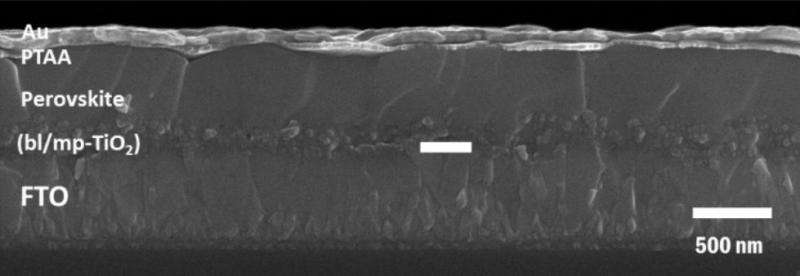May 22, 2015 report
Researchers develop method of fabricating perovskite solar cells that is more efficient, costs less

(Phys.org)—A team of researchers working at the Korea Research Institute of Chemical Technology in South Korea, has found a way to make fabricating perovskite based solar cells that is both more efficient and costs less than other current methods. In their paper published in the journal Science, the team describes their process and the efficiencies they were able to achieve.
As scientists have reached what appears to be the efficiency limit for solar cells based on silicon, the search has been on for a material to replace it, one that is at least as efficient, cost effective and will last for as long as possible. One such material perovskite, has been making headlines of late, as researchers have been improving its solar efficiency rating at a remarkable pace, from 14 percent in 2012, to 20 percent last year (the fastest that a solar technology has ever advanced). Now, it appears that mark has been raised again by the same team in Korea.
Perovskite is a mineral made of calcium titanate—its use in solar cells is mostly found as a hybrid organic-inorganic lead as part of the active (light-harvesting) layer. It does not need to go through the multi-step process seen with silicon to be used in making solar cells, nor require the clean room, high temperature or a vacuum. The new process developed by the team in Korea involves placing a lead iodide–dimethylsulfoxide layer onto a formamidinium iodide solution—which causes the formation of a formamidinium lead iodide perovskite composition. The result is a more efficient cell as it allows for gathering a broader spectrum of light. Thus far, the team reports that cells made with their new method have reached efficiencies of up to 20.2 percent. They also claim that their method also allows for producing the cells more cheaply than other fabrication methods.
What is still not clear is how well such cells can stand up to environmental conditions over long periods of time—some other recent research by other teams has suggested they may not be able to maintain their efficiencies over reasonable timescales. Still, because of its promise, several start-ups have promised sales of such cells to consumers as early as 2017.
More information: High-performance photovoltaic perovskite layers fabricated through intramolecular exchange, Science, DOI: 10.1126/science.aaa9272
ABSTRACT
The band gap of formamidinium lead iodide (FAPbI3) perovskites allows broader absorption of the solar spectrum compared to conventional methylammonium lead iodide (MAPbI3). The optoelectronic properties of perovskite films are closely related to the film-quality, so depositing dense and uniform films is crucial for fabricating high-performance perovskite solar cells (PSCs). We report an approach for depositing high-quality FAPbI3 films, involving FAPbI3 crystallization by the direct intramolecular exchange of dimethylsulfoxide (DMSO) molecules intercalated in PbI2 with formamidinium iodide. This process produces FAPbI3 films with (111)-preferred crystallographic orientation, large-grained dense microstructures, and flat surfaces without residual PbI2. Using films prepared by this technique, FAPbI3-based PSCs with maximum power conversion efficiency of over 20% were fabricated.
Journal information: Science
© 2015 Tech Xplore





















